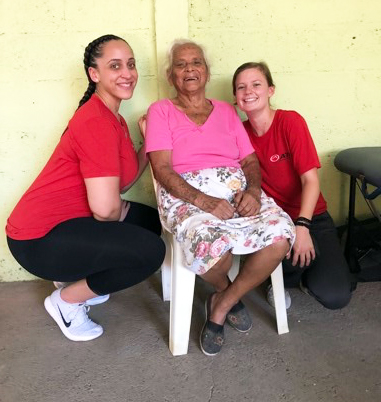By: Erin Doyle
Growing up, I was taught one simple yet important lesson, which was to put others before yourself. I never truly acknowledged the power of this lesson until my recent travels to Zacapa, Guatemala. With the help of ATI and Hearts in Motion, myself and four others from several cities across the country boarded our planes with the same binding eagerness for the journey ahead, regardless of our primitive knowledge about Guatemalan culture. With one shared mission in mind, to provide those in need with exceptional physical therapy and medical services, we set off to provide a better life for those in need.
Following an orthopedic surgeon’s trip, our duty was to ensure proper recovery and rehabilitation. This is the mission we had in mind at least, little did we know we would be serving these people in a much deeper way.
According to the Center of Disease Control and Prevention (CDC), there are 0.93 physicians per 1,000 people in Guatemala. Comparatively, the prevalence of physicians per 1,000 people is raised to 2.3 in the United States. Not only are there small numbers of health care providers in Guatemala, but they are typically concentrated in the cities.
As poverty is a norm, transportation to the city for medical care is not feasible to most. In addition, most Guatemalan citizens do not have health insurance, forcing them to pay out of pocket for private health care or wait in understaffed and underequipped public hospitals.
To truly understand the severity of this situation, one of the patients we treated recently underwent femur reconstruction, requiring a metal rod. The hospital would perform the surgery, however they did not have a rod available, so the patient was required to save money to purchase a rod himself, which delayed the surgery six months. Finally, the patient purchased the rod and was admitted for surgery, only to find out that the rod was too long for his femur, as the doctor did not provide the patient with the correct measurement information. Nevertheless, the doctor still inserted the rod because they claimed, “something is better than nothing”. Stories like this are not uncommon in Guatemala; many times over the course of my trip I was found in complete dismay from medical stories, some of which practically dropped my jaw to the floor. But gratefully, through this trip, we were still able to help a lot of people find their way to a healthier lifer. I am so blessed to have been given this opportunity to serve.
In addition to physical therapy, we provided patients with general medical services – something we would go to our primary care physician for here in the states. We monitored blood pressure, cleaned wounds and took comprehensive medical histories. In addition, we provided ankle-foot orthosis, joint braces, canes, walkers and wheelchairs to those who needed them. The most important quality we provided our Guatemalan patients with was education. Knowledge about living a healthy lifestyle through physical activity and diet is not prevalent. With our help, our patients now know how to live a healthy fulfilling life free of pain.

Despite the poverty-stricken living conditions, the Guatemalan people were among the most joyous and grateful individuals I have ever encountered. In the states, physical therapy is often seen as an intermediate step, blocking people from surgery or further testing. On the contrary, physical therapy is the sole option for Guatemalans in pain. Because of this high necessity, many individuals waited hours on end to be treated by our team. The gratefulness shown after treatment is simply indescribable. We were given hugs and kisses, offered thanks and prayers and rewarded with Guatemalan desserts and goodies. The sincerity of Guatemalan people made me realize how something easily accessible can quickly be taken for granted.
I experienced the true art of connection while in Guatemala. My role, as the rehabilitation technician on the team, was to provide home exercise programs, teach proper technique, stretch patients out and educate on the importance of keeping up with the assigned exercises. Although I was not able to physically manipulate a patient’s joint or diagnose the issue, I offered what I had to give: assistance, knowledge, education or even a simple smile and hug. Despite the language barrier, connection was practically effortless. It amazed me how far simple eye contact, smiles, laughs and gestures could go.
What the people of Guatemala don’t know is that they touched and taught me even more. Their warm, hospitable personalities taught me to maintain an open-mind about other lifestyles. Their living conditions taught me to be grateful and not take anything for granted. The entire experience taught me to constantly give to others. No matter how small, offer what you have to others first. Whether its knowledge and skills or simply time and a smile, always give anything you can.
I would recommend a Global Reach trip to any ATI employee. Treating patients in a third world country not only exposes you to a different culture, but allows you to challenge your practice, learn about yourself and experience true connections. Thank you to ATI and Hearts in Motion for an incredible trip!